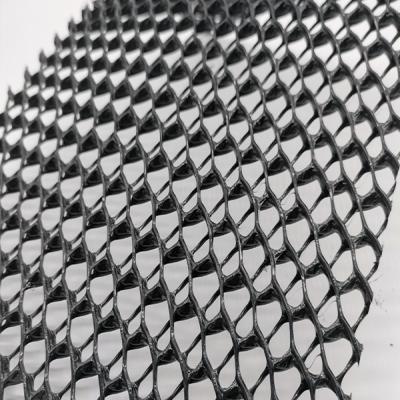一. Construction preparation stage
1、Design scheme determination
Before construction, according to the actual situation of the project, detailed three-dimensional plan should be formulated Composite drainage network The laying scheme. Including key elements such as material selection, dosage calculation, laying location and method, etc., to ensure that the scheme is scientific and reasonable and meets the project needs.
2、Site clearance and foundation treatment
Clean the construction area thoroughly to ensure that the ground is flat and free of debris, so as to facilitate subsequent construction operations. It is also necessary to carry out basic treatment on the area where the drainage network is laid, such as tamping the base, laying cushions, etc., so as to ensure that the drainage network is stably installed and the drainage effect is good.
二. Material inspection and cutting
Conduct quality inspection on the three-dimensional composite drainage network to ensure that it meets the design requirements. According to the actual size of the laying area, the drainage net is accurately cut, so as to improve the utilization rate of materials and reduce waste.
三. Pay-out positioning
According to the design scheme, the setting-out positioning is carried out in the construction area. The three-dimensional composite drainage network should be laid in two directions: the transverse drainage network perpendicular to the dam axis and the longitudinal drainage network parallel to the dam axis. Accurate measurement and marking can determine the laying position and spacing of drainage nets.
四. Trenching and laying
1、Digging trenches
According to the setting-out position, the ditch for laying the three-dimensional composite drainage network is excavated. The width and depth of the ditch bottom should be determined according to the design requirements, so as to ensure the stable installation of the drainage network and the drainage effect.
2、Laying drainage networks
The cut three-dimensional composite drainage net is laid flat in the ditch according to the design requirements. The horizontal drainage network should extend out of the dam body and be laid flat on the slope at the foot of the dam slope, and the exposed part should be pressed with stones and other fixtures. Then lay the longitudinal drainage network to ensure that it is tightly connected with the horizontal drainage network to form an effective drainage system.
五. Connection and fixation
The drainage networks should be connected to each other to ensure the overall drainage performance. The connection method can adopt nylon buckles, special connectors or welding to ensure a firm connection and good sealing. Also use fixings (such as stones, sandbags, etc.) to fix the drainage net to the ground to prevent it from moving or deforming.
六. Backfilling and compaction
Evenly backfill the laid drainage net with soil or sand. Avoid impact or damage to the drainage net when backfilling. Use vibratory rollers or other compaction equipment to compact the backfill soil in layers, and the backfill thickness of each layer should not be too large to ensure the compaction effect. Compaction can not only improve the compactness and stability of backfill soil, but also help the drainage performance of drainage network.
七. Slurry discharge and acceptance
For specific projects such as wet dam construction, grouting should be carried out after the drainage network is laid. When discharging slurry, the flow and speed of slurry should be controlled to avoid damage to the drainage network. After the construction is completed, the entire construction area must be comprehensively inspected and accepted, including the laying quality of the drainage network, joint treatment, backfill compaction effect, etc., to ensure that the project meets the preliminary planning, design and standard requirements.
It can be seen from the above that the construction sequence of the three-dimensional composite drainage network is complex and delicate, and it should be operated in strict accordance with the design requirements and technical specifications.
Post time: Mar-01-2025




